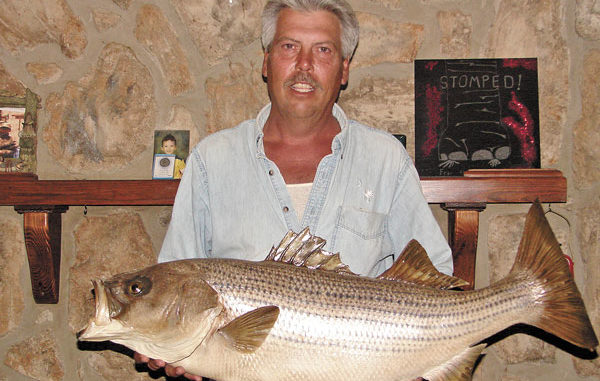
Lake Hartwell stripers respond to controlled-depth trolling
Since primitive man first speared fish with a sharpened stick, he has devised different ways to accomplish his objective. Some are more successful than others, but today there are advocates for a vast array of techniques.
Controlled-depth trolling is one of those, and it has devoted followers that will rarely fish any other way. Kevin Warren is such a man. He has been on a mission for several years to refine his techniques and make them easy to pass on to others — teaching them that it’s a great, inexpensive way to catch fish, especially on his home waters of Lake Hartwell.
A Kentucky native, Warren has lived on Hartwell since 1984. That’s given him plenty of time to perfect a system that can be deadly on stripers and hybrids. He has designed an extremely strong umbrella-rig he calls Trollbaby, and he’s most-recently reached one goal: securing all of its components from manufacturers within the United States.
The umbrella-rig technique for trolling was developed on the Great Lakes, but Warren has refined it for southern lakes, improved the quality and is sharing his findings with other fishermen. Umbrella-rig trolling can be a dedicated technique, or it can be used as a searching tool and combined with casting lures or down-lining live bait after fish are located. As opposed to searching with the boat’s electronics, the combination of depthfinder and umbrella rig lets a fisherman know there are fish present, and also that they are actively feeding.
Downriggers are also used in the Great Lakes, but at Lake Hartwell, the standing timber makes them impracticable. Submerged timber provides great cover for fish, but it can result in excessive hang-ups and lost lures.
Warren incorporates several methods of trolling into his tactics. If fish are deep, he reaches them with leadcore line. He rarely trolls deeper than 40 feet due to the standing timber, and by watching his depthfinder, if he detects any timber, he can reel his lines in quickly enough to avoid most hang-ups.
Trolling depth is controlled by regulating speed and releasing line. Leadcore is dyed a different color every 10 yards, so anglers can easily release the desired amount of line to reach the proper depth. Reels with line counters are a convenience and make it easier for the average person to manage things properly.
Planers like Dipsy Divers are an alternate method used to get lures deep, and they do not require lead- core line. They can be set to release when a fish strikes, or a fisherman can snatch the rod and release the planer if it he or she spots timber on the depthfinder and wants to avoid a hangup.
Planers can be set to “plane out” to the side, and by using two on the side and two rods with leadcore off the transom, a 4-rod spread is a option that two fishermen can manage properly.
Lure presentation is normally about five feet above the depth where fish show up on the depthfinder. Most fish will rise to a bait, but few will go deeper.
Warren has a favorite “measured mile” on the lake where he can occasionally check his speed accurately and be sure that he is reaching the proper depths.
Warren lives at the mouth of Little Beaverdam Creek and often has to go no further than the junction of the Tugaloo and Seneca Rivers nearby to find some fast action. It is not uncommon to catch two stripers at the same time on umbrella rigs. One of the problems he had before developing his Trollbaby was when two fish hooked up at the same time, the violent jerking would often destroy the rig.
Being able to troll from the surface down to 40 feet and using a depthfinder, if fish are active, it is easy to locate and catch them. The only difficult periods are several times a year when the lake “turns over” and fish are not responsive. This usually is only a couple of times a year and only lasts a couple of weeks.
When using an umbrella rig, about 70 percent of the fish Warren catches are on the trailing bait. A few states ban using multiple-hook rigs, so only the trailing bait can carry a hook, but South Carolina allows multiple-hook rigs, which leads to some exciting hookups with doubles. When trolling through active fish, Warren likes to wait a few seconds after a strike and put his boat in neutral; that often leads to a second strike.
Devotees of controlled-depth trolling can also troll live bait. Leadcore line, planer boards or Dipsy Divers offer a range of methods to control the presentation and reach depths where fish are holding.
Ashton Langley of Travelers Rest caught a 27-pound striper on a planer board and live bait at Lake Russell in late May; the fish hit a bait about 12 feet deep. After a 25-minute fight, he was sold on controlled-depth trolling.
In addition to watching the depthfinder, a fisherman should keep an eye on the horizon, searching for birds diving on baitfish. Also, watch for baitfish and boils on the surface as stripers and hybrids hammer them. Often, a chance sighting of birds or fish activity can lead to some hot action.
One hot spot for spring and fall action on Lake Hartwell is a wide flat on Big Beaverdam Creek. After you head into the creek a short distance, the channel widens and covers a large area that averages about 14 feet deep. A few passes around the perimeter will normally yield some great fun. Once the water gets extremely hot in the summer or cold in the winter, the fish will seek a more comfortable temperature in the deeper parts of the lake.
Trolling is a laid-back way of fishing. Once lines are set out to the desired length and depth, it’s a matter of charting a course and watching the sonar. Once you pattern the fish, you can count on it lasting for several days or weeks, but be ready to change up when it quits working. Trolling is not for everyone, but for those that are dedicated to the method, it can be deadly.
On a recent trip with Warren, the catch was of fish averaging five to seven pounds, but he regularly catches fish in the teens and has a 25-pound striper to his credit. Warren doesn’t target big fish, and most of the time, he releases the stripers and hybrids he catches. He is quick to share his methods and locations with friends and fellow anglers.
“There is lots of water, and plenty of fish for everyone,” he said.

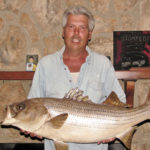
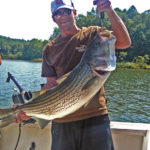
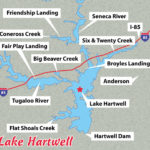
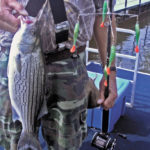
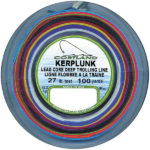
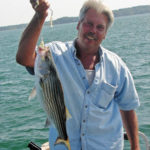
Be the first to comment